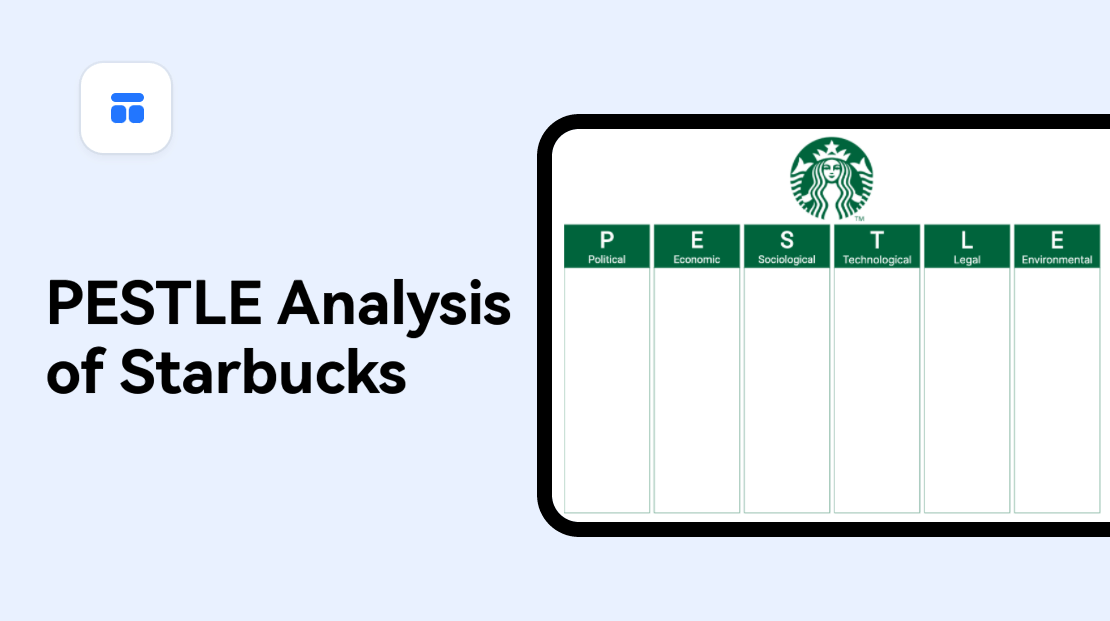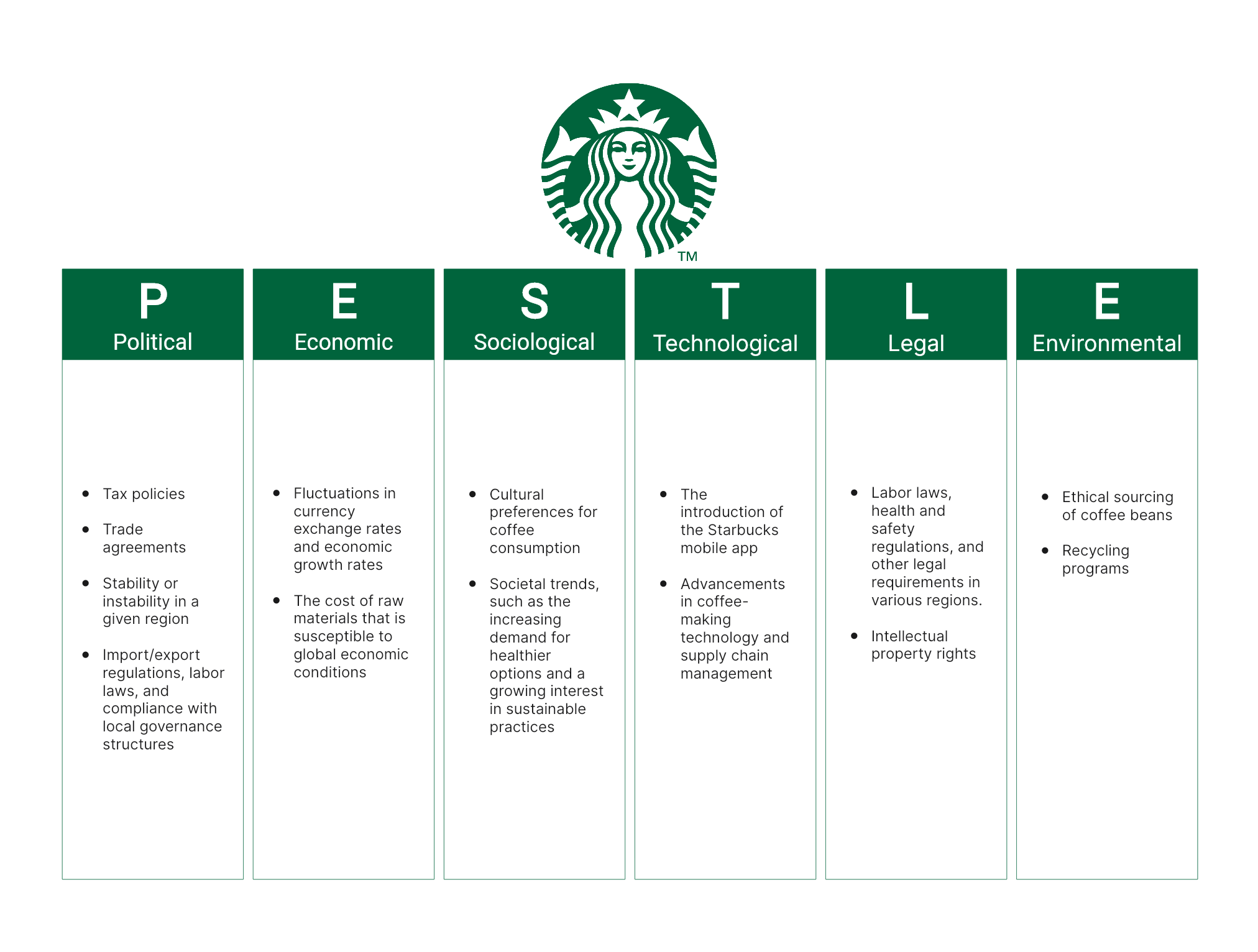In the dynamic landscape of modern business, understanding the external factors that influence a company's operations is crucial. One powerful tool for this purpose is the PESTLE analysis. By examining the Political, Economic, Sociocultural, Technological, Legal, and Environmental aspects, businesses can gain a comprehensive view of their environment. In this article, we'll explore the PESTLE analysis of Starbucks.

What Is the PESTLE Analysis
A PESTLE analysis is a strategic management tool that provides a comprehensive framework for understanding the macro-environmental factors that can impact an organization. These factors are:

- Political: This encompasses government policies, regulations, and political stability. In Starbucks' case, differing tax policies and trade regulations in various countries can significantly affect its operations.
- Economic: Economic factors include inflation rates, exchange rates, and economic growth. For Starbucks, economic trends play a pivotal role in consumer spending habits on premium coffee.
- Sociocultural: This factor looks at cultural norms, values, and demographic trends. Starbucks, being a cultural icon, must adapt to diverse cultural preferences for coffee consumption across regions.
- Technological: This involves evaluating the level of technological adoption and innovation in the industry. Starbucks' investments in mobile apps and digital payment systems reflect its commitment to leveraging technology.
- Legal: Legal factors encompass laws and regulations that affect a company's operations. For Starbucks, adherence to labor laws, health and safety regulations, and intellectual property rights is imperative.
- Environmental: This includes factors related to sustainability, climate change, and environmental policies. Starbucks' emphasis on sustainability, from ethical sourcing to recycling initiatives, reflects its commitment to environmental responsibility.
Basic Info of Starbucks
Starbucks, founded in 1971 in Seattle, Washington, has grown into one of the world's most recognizable brands. Its mission to "inspire and nurture the human spirit - one person, one cup, and one neighborhood at a time" underscores its commitment to both quality coffee and community.
With over 30,000 locations worldwide, Starbucks is a global phenomenon. Known for its diverse menu offerings, from the classic Caffè Latte to seasonal specialties, Starbucks has a product range that caters to a wide array of consumer tastes.

PESTLE Analysis of Starbucks
Here is PESTLE analysis example of Starbucks:

Political Factors
Starbucks operates in numerous countries, each with its own political landscape. The company must navigate through various government policies and regulations that can significantly impact its operations. For instance, tax policies, trade agreements, and stability or instability in a given region can have direct implications on Starbucks' profitability and expansion plans.
In some markets, Starbucks may face challenges related to import/export regulations, labor laws, and compliance with local governance structures. This means the company must maintain a strong understanding of the political climate in each region to ensure smooth operations.
Economic Factors
Economic conditions play a pivotal role in Starbucks' performance. Fluctuations in currency exchange rates and economic growth rates can greatly affect the company's revenue. During economic downturns, consumers might reduce discretionary spending, impacting Starbucks as a premium brand.
Additionally, the cost of raw materials, especially coffee beans, is susceptible to global economic conditions. This can affect Starbucks' profitability, and the company may need to adapt its pricing strategies accordingly.
Sociocultural Factors
Cultural preferences for coffee consumption vary widely across different regions and demographics. While espresso-based beverages may dominate in Italy, tea remains the preferred choice in many Asian countries. Starbucks, as a global brand, must tailor its menu offerings and marketing strategies to cater to these diverse preferences.
Moreover, societal trends, such as the increasing demand for healthier options and a growing interest in sustainable practices, have a significant impact on Starbucks' product development and marketing efforts. The company's ability to anticipate and respond to these cultural shifts is crucial for maintaining customer loyalty.
Technological Factors
Starbucks has been at the forefront of integrating technology into its operations. The introduction of the Starbucks mobile app, for instance, revolutionized the coffee industry. This app allows customers to place orders, pay, and earn rewards seamlessly. Such technological innovations enhance the customer experience, driving loyalty and increasing operational efficiency.
Furthermore, advancements in coffee-making technology and supply chain management have enabled Starbucks to maintain consistency in product quality across its vast network of stores.
Legal Factors
Compliance with local and international legal standards is paramount for Starbucks, which operates in a highly regulated industry. This includes adherence to labor laws, health and safety regulations, and other legal requirements in various regions.
Additionally, protecting its intellectual property rights is crucial for Starbucks. This ensures that the brand and its unique recipes are safeguarded from imitation and infringement.
Environmental Factors
Starbucks has taken significant strides in environmental responsibility. The company's commitment to sustainability is evident in various initiatives, including ethical sourcing of coffee beans and implementing recycling programs. These efforts align with the growing global focus on eco-conscious practices and resonate with environmentally conscious consumers.
Starbucks' dedication to reducing its environmental footprint not only reflects corporate social responsibility but also appeals to a broader customer base that values sustainable practices.
Insights from the PESTLE Analysis of Starbucks
The PESTLE analysis of Starbucks reveals a nuanced understanding of the external factors that exert influence on the company's operations. It highlights the intricate interplay between political, economic, sociocultural, technological, legal, and environmental elements. Starbucks' adaptability to diverse political landscapes and economic conditions showcases its resilience.
Moreover, the company's ability to cater to varying cultural preferences, integrate cutting-edge technology, and uphold legal compliance underscores its agility in a dynamic market. Additionally, Starbucks' commitment to sustainability aligns with a growing global emphasis on eco-conscious practices, enhancing its appeal to environmentally conscious consumers. By leveraging these insights, Starbucks can not only navigate challenges but also seize opportunities for sustained growth and continued success on a global scale.
Key Takeaway: A One-stop Tool for PESTLE Analysis
This PESTLE analysis of Starbucks serves as a testament to the power of the PESTLE framework in understanding the broader factors that shape a company's success. By employing Boardmix, a one-stop online whiteboard tool, businesses can make informed decisions and navigate the complexities of the modern business world.









